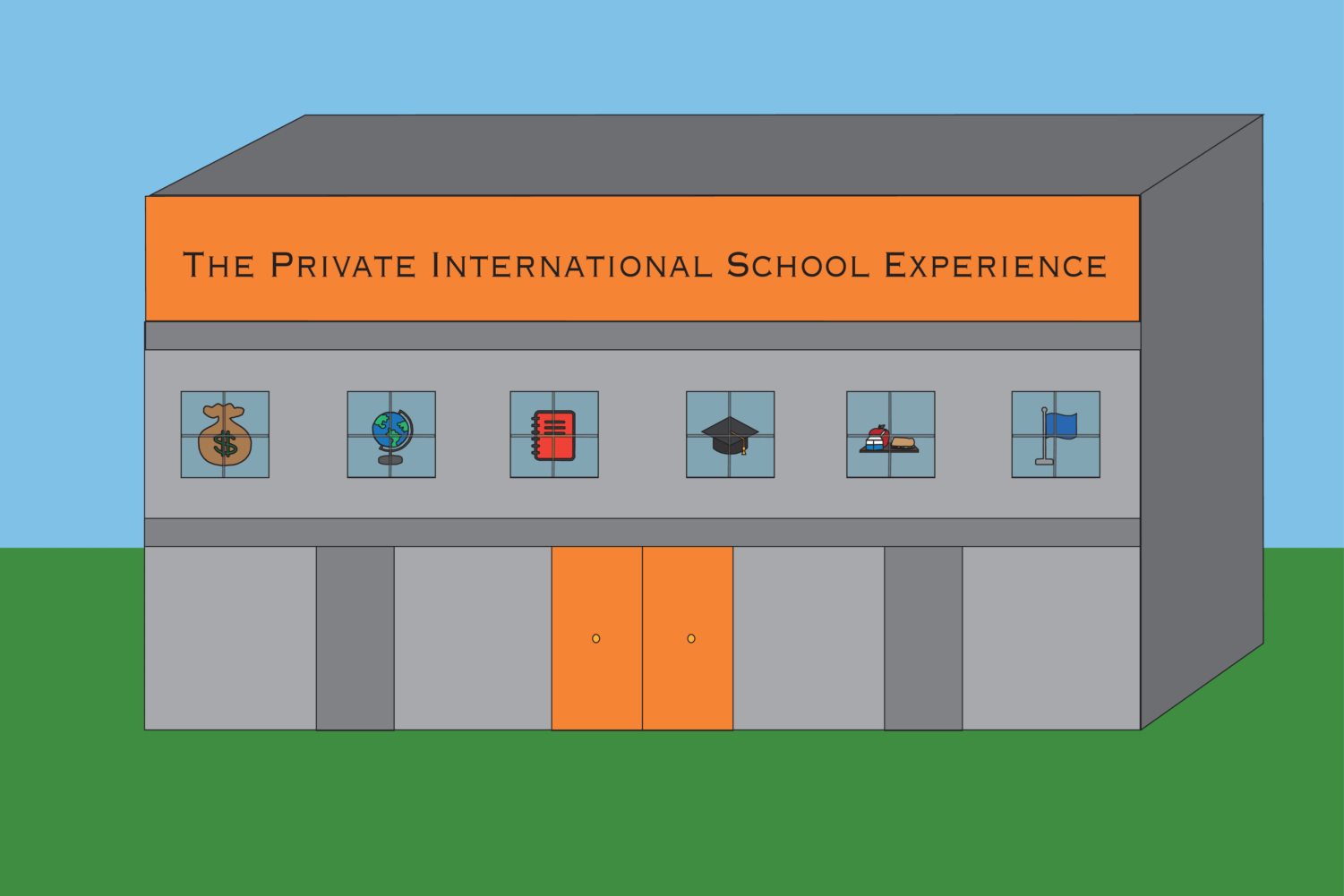Students, faculty explore dynamics of different education systems
June 14, 2021
The name American School in London acts as an immediate indicator of the school’s various traits and its role in the community environment.
Members of the community consider distinctive characteristics of the school – being American, private, and international – and how they compare to previous institutions at which they have studied or worked.
School environment
Social Studies Teacher Lina Densley moved to London for the 2019-2020 school year after teaching at numerous schools in the U.S., ranging from public to private to charter. Upon arrival, Densley said she felt the school was inclusive of new faculty.
“As far as reaching out to teachers, making sure that they’re welcome, having groups for all the newbie teachers to be able to go out and do adventures and things together and get to know each other, ASL does a really good job of that,” she said.
Choir Director Ben Waltz began teaching at ASL the same year as Densley after teaching at multiple public schools in the U.S. Similarly, he said the school has certain methods in place such as the DEI Statement, which helps to constantly evaluate how to best welcome people, particularly minority groups, into the community.
“There are really intentional conversations around our Diversity, Equity and Inclusion Statement about what does that actually mean for new folks at ASL who may not feel welcome everywhere,” he said. “I like that the school is examining what that actually means, not just saying, but actually examining.”
Fernando Hartogs (’24), originally from Brazil, joined the school in K1. He said there was a language barrier when he initially started at the school. Through teachers’ support, however, he said he adapted quickly to the environment, eventually becoming fluent in English.
“I was always very supported by the teachers, especially with speaking English and learning English because coming from Brazil, I didn’t really speak English whatsoever,” he said.
Furthermore, Stella Schabel (’22) said teachers at ASL are always very willing to spend additional time working with students and go above and beyond planning lessons in comparison to the previous school she attended. Although Schabel started at the school in K2, she left in Grade 2 and moved to a German school in Hong Kong with a British curriculum before returning to ASL in the middle of Grade 5.
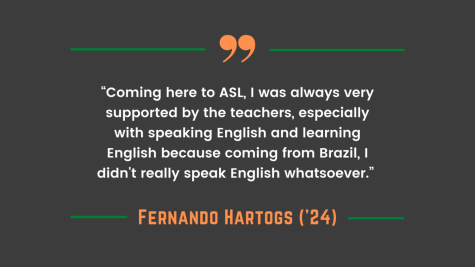
“I really felt a difference between the teaching style,” she said. “The teachers are just really passionate about what they teach, which is something that is so awesome.”
Schabel said ASL has proven to be a much more inclusive environment as the competitive ways of her old school created division among students.
“They would highlight the good students,” she said. “If some students were getting a lot of awards or whatever, they would put that on their Facebook page or make them seem very exclusive.”
However, Waltz said ASL should be particularly conscious about making incoming members of the community feel welcome and included now and in the coming years due to the isolating effects of COVID-19.
“It’s more difficult right now and just making sure that everybody’s intentional about that with new students coming in and new faculty coming in for the next couple of years,” he said. “This is a shared experience, but shared from a distance, which would just create some unique circumstances.”
As a new student who joined the school in fall 2020, Percy Stillman (’23) said students are generally more friendly in the High School compared to the student body of his former British school and create an inclusive environment.
“There’s more of a student community, I’d say, to collaborate in a way that’s maybe a bit different,” he said.
Socioeconomic status
Densley has experience working in public schools where students often come from lower-income households. She said the schools supplied not only education but also basic human needs, such as food, to their students.
“Two of the schools I taught at were [in] more impoverished areas,” she said. “Many of those students were getting free lunch every day and free breakfast too and free busing to and from school.”
Densley said economic differences in education impact students’ learning and opportunities.
“We do have a lot of inequity in the way that we provide for education, not just within the U.S. but globally,” she said. “I could teach at a public school that was down the street from the charter school I taught at, and the difference in the quality of education between those two schools was astronomical.”
Alternatively, Principal Devan Ganeshananthan said it was the norm for all New York City-area private schools to provide financial aid, including St. Ann’s School, where he worked as a math teacher and coached track and field.
“It’s an industry standard that the school is going to give some level of financial aid,” he said. “That is not, from my knowledge, that much of an industry standard in international independent schools.”
Zein Blanks (’22) said the majority of families at the school have a high-income background, which constitutes a lack of awareness for students. She said ASL combats the socioeconomic bubble by increasing students’ experience and awareness of what lies outside of the bubble.
“To be the well-rounded person that ASL tries to create and harness in relation to the world, part of that is exposure to different socioeconomic people from different socioeconomic classes,” Blanks said.
Ganeshananthan said the presence of financial aid is recognized among the community and sometimes runs the risk of increasing tension or a divide between students of different socioeconomic backgrounds.
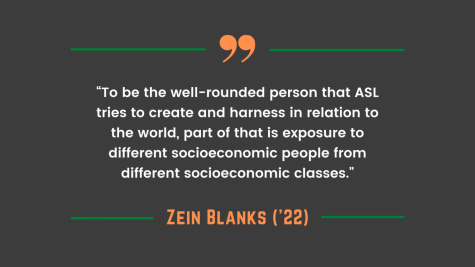
Furthermore, Ganeshananthan said in order to provide anonymity for students on financial aid, families’ circumstances are kept completely confidential.
“Once students are admitted, no one actually knows outside of the admissions office who is actually on financial aid or whatnot, so students are treated, you know, independently of that,” he said. “The expectation is that every single student is going to be supported, regardless of their ability to pay.”
Moving forward, Densley said she wants the school community to further develop its acceptance of families from various socioeconomic classes.
“I would like to see us continue to grow in respect to creating a more inclusive environment and continuing to open ourselves up for more diversity in socioeconomic status,” she said.
Diversity
With ASL classified as an international school, Schabel said this premise brings people from a variety of different backgrounds together. Through exposure to a wide range of environments, she said students gain a stronger perception of how peoples’ experiences vary and shape their understanding of the world.
“It’s really an advantage to have lots of different perspectives, people coming from all over the place,” Schabel said. “It’s a privilege to be able to just learn with all these different people and hear about their stories.”
Additionally, Ganeshananthan said diversity can take many forms depending on the context, and within an international school like ASL, “people will have a proclivity to really take a look at what is most apparent, which is racial diversity, or perhaps gender diversity.”
While Ganeshananthan said he acknowledges the community’s lack of racial diversity, he said it is not the sole attribute of a diverse population, and the school has diversity in other areas, such as nationality.
“The level of racial diversity is not nearly what it was in the previous schools that I’ve worked, but then there are also different types of diversity here that were absent from other schools that I’ve worked in,” he said.
Similarly, World Languages and Cultures Teacher Annie Yousey said the school community has a wide variety of diverse backgrounds in comparison to working at Korea International School – KIS – for five years.
“There is a lot more diversity as far as the different countries that are represented and different people that are from different places,” she said.
Blanks, who was recently elected as one of the new co-presidents for the Social Justice Council, said the school lacks diversity not in the actual population, but in its execution of discussion when conversations pertain to social justice. Nevertheless, she said in attempting to develop the diversity program, the community is taking steps forward.
“The effectiveness of things like the anti-racism program in advisories and like all these different programs that try and incorporate other aspects of the identifiers is debatable,” she said. “But that effort – like in the emphasis of trying to expose the students to these things – is very important and unique.”
Additionally, Ganeshananthan said the school aims to hire faculty the student body can feel represented by, such as teachers of color or women teaching more advanced math and science courses.
“We want to make sure that students see themselves reflected in their teachers,” he said. “Representation absolutely matters. It’s a major, major point of focus with that in relation to recruiting, hiring and retention.”
Nevertheless, Ganeshananthan said hiring committees prioritize finding the best-suited educator for the school.
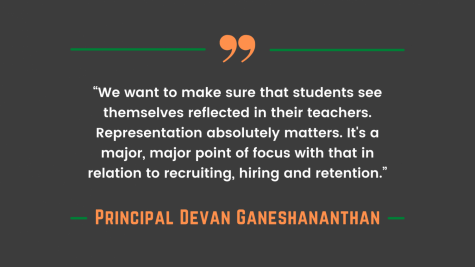
Waltz said ASL differs from the other schools he has taught at in terms of its openness to diversity. However, Waltz said the change has made him reconsider working in a private school because he is not presented with the same opportunities to help students.
In the public system, Waltz said schools often need to be more accepting of racial diversity, and he can contribute more directly to that change “through racial justice issues or promoting safe, inclusive curriculum and education or student groups.”
Despite the benefits of private school education, Waltz said overall he prefers teaching in a public school system because of the impact he can have on students from a variety of backgrounds.
“[Public schools] are incredibly imperfect, but I feel like I have a really strong sense of a wider purpose there – working with students from backgrounds that are incredible or unfortunate … and being the best teacher for everybody,” he said.
Ultimately, Waltz said he has decided to return to the U.S. at the end of the school year in order to pursue his passion for teaching in public education systems and search for environments where he can have a greater influence as a voice of change.
“I do know that the communities that I will most likely be working in tend to skew a little less progressive than ASL and London, and those are the only types of communities I’ve worked in prior to working here, and so I have a stronger sense of how to provide safety to students who may be afraid to ask,” he said.
Education and curriculum
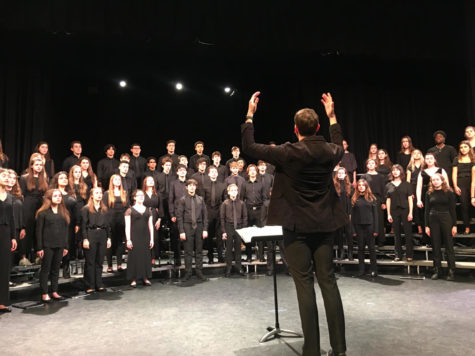
Different school systems have varying degrees of state guidance regarding curriculum, which Waltz said is a positive aspect of teaching at a private school.
“In the States, your curriculum is guided by government decisions,” he said. “It’s just a little bit differently structured here in some really cool ways.”
Furthermore, Densley said an advantage to teaching at a private school is increased liberty in teaching style and materials.
“Having that freedom to let teachers do their jobs and use our own background and expertise is, I think, a real benefit to the school and our students,” she said.
Yousey said she was accustomed to a different curriculum based primarily on memorization at KIS. She said in the American system, there is a larger focus on understanding and using concepts like conjugations.
When Yousey started teaching at KIS, she said she distributed a list of vocabulary terms to her students and expected to spend the future classes practicing them. However, she said much to her surprise, her students came into the next class with the list fully memorized and ready to apply the words.
“Memorizing was something that those students did really well, just because they were used to that from a lot of their schooling,” Yousey said. “Whereas here, a lot more students are used to more of the American system, where you learn a concept and how to do it and how to apply it.”
Schabel said the student body of her school in Hong Kong was similarly engaged in their learning, but facilitated a judgmental environment and extremes in which students would hire tutors not to catch them up on challenging material, but to “get ahead of the class.”
At ASL, however, Schabel said knowledge and comprehension are priorities in classes, something she prefers to the emphasis her previous school placed on students’ results.
“British systems are very like, grade focused and test score focused and not so focused on the content and really understanding,” she said. “It’s more about, ‘Oh, what am I going to get on this test,’ and that was not something that sat well with me.”
In contrast to the rigidity of GCSEs in the British system, Stillman said a benefit of attending an American school is that he can study a variety of subjects.
“At a British school, you have to commit to a certain few subjects from a younger age, and then you basically just narrow down from there, so it’s nice to be able to take new classes,” he said. “I hadn’t chosen art for my GCSEs, which meant that I was not going to do another art class during my time there.”
While teaching at public schools, Densley said one classroom could contain up to 40 students. In the High School, class sizes are much smaller – Densley said she estimates there is an average of 18 students per class.
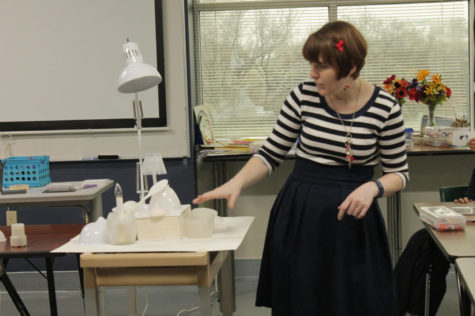
Densley said teaching fewer students at one time is an advantage of a private school because more recognition can be given to each student.
“The amount of attention and individualized support that I’m able to give to students here is very different than what I was capable of giving to students of a public school,” she said.
Similarly, Blanks said the relationships between students and teachers at the school are constructive. She said there is more of a focus on these relationships in comparison to her experiences at previous schools.
“ASL definitely prides itself more on student-teacher connections and harnessing those connections, which I think is great,” Blanks said. “My other schools, it happened or it didn’t … It wasn’t something that they really tried to foster.”
Waltz said another enjoyable characteristic of teaching at ASL is the professional development programs offered to faculty.
“I’m grateful for the professional development provided by ASL,” he said. “This is a school that really wants teachers to be doing their best and providing them opportunities to do their best.”
Social interactions and cliques
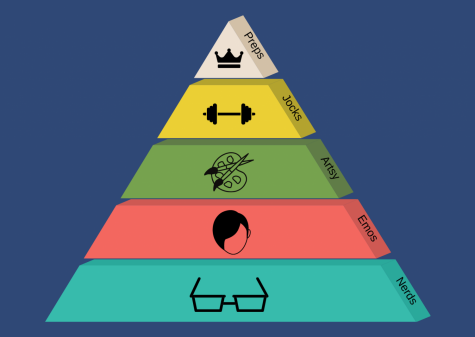
Ganeshananthan started in the High School in fall 2018 and said one key difference he quickly realized was that ASL has a smaller population size than his previous schools. Ganeshananthan said he worked as a house principal at New Rochelle High School in New York, which has a student population of 3,485. In comparison, the High School has a student population of 491.
Ganeshananthan said despite the student body being divided into houses at New Rochelle, these groups remained relatively large, whereas at ASL, the smaller population facilitates closer bonds between students and their teachers. He said his house contained 700 to 800 students – around a quarter of the student body.
“Even that size, you’re still not able to really get to know everyone in a close fashion that you can when there are only 120 kids here in each grade,” he said.
While teaching in public schools, Densley said she often taught far more students. She said while it made it unlikely for her to get to know everyone, it allows students to have anonymity when there are conflicts within social circles.
On the other hand, Densley said news spreads quickly at ASL, which holds students to higher expectations and as a result, induces a certain amount of stress.
“Because everything is so connected, when anything happens, everybody knows about it and it can create a lot of pressure,” she said. “That doesn’t exist in the same way at the public schools.”
Hartogs said cliques are prevalent in the school, thus making it challenging for students to branch out.
“People don’t really want to move around, and they stay in their own group because they feel safe that way,” he said. “A lot of these people in ASL have been nurtured in a way that they stick to what they got and they don’t really try to explore other things.”
Additionally, Yousey said socioeconomic status can further impact social interactions and relationships throughout the entire school community.
“Some students naturally hang out together and include each other because they’re from the same level of class, and they can afford to do the same kinds of things,” she said. “If your child’s in elementary, then they connect because their parents or nannies connect during pick up time, and they have friends that way, whereas parents who are working can’t make those connections.”
Regarding students’ interactions in society, Blanks said attending a well-funded private school such as ASL can hinder one from venturing outside the community. She previously attended Cairo American College and the American School in Dubai before moving to the School in Grade 6.
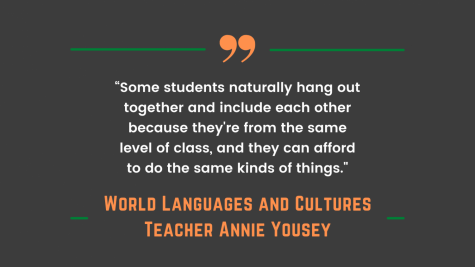
“The pros are obviously the resources, the education,” she said. “The quality of those things is just unmatched honestly,” she said. “The cons, though, is sometimes being so— because it’s an American school in London and it’s a private school, you kind of get closed off from the rest of the world.”
Moreover, Densley said surrounding oneself with others who have different experiences is crucial for self-growth despite COVID-19 restrictions reducing the ability to branch out.
“It’s very easy to just stay in our little bubble of ASL, and I’m guilty of that myself, especially with the COVID pandemic and all of this – not being able to go out and meet people outside of our space,” she said. “But having the opportunity to do that really does expand your view in a lot of ways.”
However, Densley said in comparison to the previous communities she has worked in, the ASL community is generally more aware of the wider world.
“ASL does a better job of at least recognizing that ideas exist beyond the world you live in and beyond your perspective,” she said. “We could do a better job of being more accepting and inclusive, but I think we’re also working on that.”
Students worldwide
After teaching in four different schools, Yousey said the profession requires a balance of different approaches. Depending on students’ needs, she said exposing students to a multitude of learning styles is most effective.
“I’ve always asked myself that question – ‘What is the best way to teach?’” Yousey said. “It depends what your goals are, and if our goal is communication and cultural competency, then I think a combination is good.”
Yousey said she has found similarities between students in different school systems, despite every student being unique.
“They have a lot of the same needs in all those places that I’ve taught,” she said. “They’re motivated by interesting material, some students learn more quickly, others learn more slowly.”
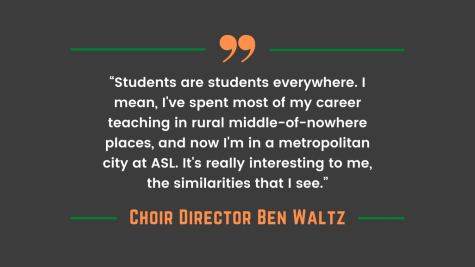
Ganeshananthan said connections in education systems are a global way for the students within them to thrive.
“Through the six schools that I’ve worked at, the most important thing is relationships,” he said. “Schools are very delicate, you know, ecosystems that can fall apart, and ultimately that is really going to be underpinning any kind of progress, or growth or development for any students or the school.”
Similarly, Waltz said one consistency through his teaching experiences in different environments is the parallels of student growth in different locations.
“Students are students everywhere,” he said. “I mean, I’ve spent most of my career teaching in rural middle-of-nowhere places, and now I’m in a metropolitan city at ASL. It’s really interesting to me, the similarities that I see.”
Moreover, Densley said there will always be correlations among students, despite being at schools with various people, environments and socioeconomic backgrounds.
“Some facts of just being a teenager are sort of universal to an extent,” she said. “That’s something I’ve seen a lot of, is that at the end of the day, kids are kids no matter where they are.”

